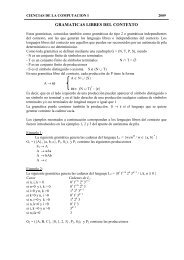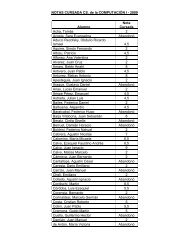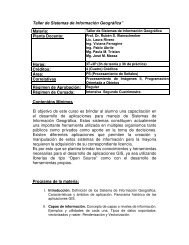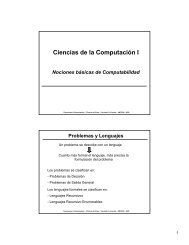Libro de Resúmenes / Book of Abstracts (Español/English)
Libro de Resúmenes / Book of Abstracts (Español/English)
Libro de Resúmenes / Book of Abstracts (Español/English)
Create successful ePaper yourself
Turn your PDF publications into a flip-book with our unique Google optimized e-Paper software.
Resumenes 146<br />
• Si X es compacto entonces : f periódicamente<br />
<strong>de</strong>nsa⇒<br />
f periódicamente<br />
<strong>de</strong>nsa<br />
• f es mezclante ⇔ f es mezclante<br />
• f tieneentropía<br />
topológica positiva ⇔ f tieneentropía<br />
topológica positiva<br />
También, diversos aspectos teóricos y aplicados en abierto serán discutidos.<br />
Individual and collective dynamics: chaotic relations 2<br />
It is well known that a numerous class <strong>of</strong> real problems are mo<strong>de</strong>lled by a<br />
discrete dynamical system<br />
xn + 1 = f ( xn<br />
), n = 0,<br />
1,<br />
2,...<br />
(1)<br />
where ( X , d)<br />
is a metric space and f : X → X is a continuous function.<br />
The basic goal <strong>of</strong> the theory <strong>of</strong> discrete dynamical systems (DDS) is to<br />
2<br />
n<br />
un<strong>de</strong>rstand the nature <strong>of</strong> all orbits x,<br />
f ( x),<br />
f ( x),<br />
...., f ( x)<br />
as n becomes large<br />
and, generally, this is an impossible task. In certain sense, the study <strong>of</strong> the<br />
orbits in a DDS says us as are moved the points in the base space X and, in<br />
many cases, these orbits presents a chaotic structure.<br />
On the other hand, sometimes is not sufficient to know as are moved the<br />
points in the base space X but it is necessary to know as are moved the<br />
subsets <strong>of</strong> X what carries us to the problem <strong>of</strong> analyzing the dynamics <strong>of</strong><br />
set-valued dynamical discrete systems (SDDS).<br />
For example, it is usual today to put special transmitters on different types<br />
<strong>of</strong> biological species to know their movements within their habitats. Thus, if<br />
we <strong>de</strong>note by X the habitat <strong>of</strong> a given specie and we choose an individual<br />
representative x ∈ X , then we can obtain information about the movement<br />
<strong>of</strong> x in the ecosystem X and, <strong>of</strong> this way, we can construct an individual<br />
displacement function f : X → X . Eventually, this function could be chaotic<br />
or not, but the question now it is the following: What is the connection<br />
between the dynamic <strong>of</strong> individual movement and the dynamic <strong>of</strong> collective<br />
movement?<br />
In this direction, given a dynamical discrete system (1) we consi<strong>de</strong>r the setvalued<br />
dynamical discrete system (SDDS) associated to f :<br />
An + 1 = f ( An<br />
), n = 0,<br />
1,<br />
2,...<br />
(2)<br />
where f : K(<br />
X ) → K(<br />
X ) , f ( A)<br />
= f ( A)<br />
= { f ( a)<br />
/ a ∈ A}<br />
, is the natural extension<br />
<strong>of</strong> f to K (X ) .<br />
In this context, our main goal in this work is studying the following<br />
fundamental question: individual chaos implies collective chaos? and<br />
conversely?<br />
As a partial response to this question above, if we consi<strong>de</strong>r the space<br />
( K ( X ), H ) <strong>of</strong> all nonempty compacts subsets <strong>of</strong> X endowed with the<br />
Hausdorff metric induced by d , then the following chaotic relationships<br />
between f and f are showed:<br />
• f transitive ⇒ f transitive<br />
• f sensitively<br />
<strong>de</strong>pen<strong>de</strong>nt ⇒ f sensitively<br />
<strong>de</strong>pen<strong>de</strong>nt<br />
• If X is compact then : f periodically<br />
<strong>de</strong>nse ⇒ f periodically<br />
<strong>de</strong>nse<br />
2 Trabajo financiado por Conicyt-Chile vía Proyecto 1040303 y Dipog-UTA vía Proyecto 4731-04.



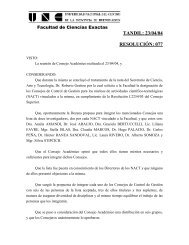
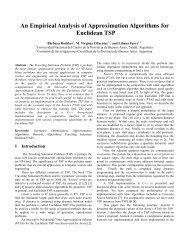
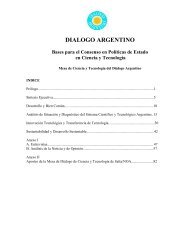
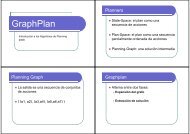

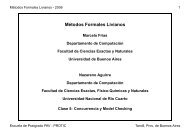
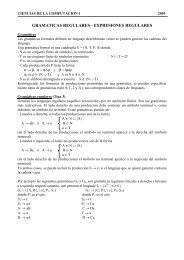

![Clase 13 [pdf]](https://img.yumpu.com/19616969/1/190x245/clase-13-pdf.jpg?quality=85)

